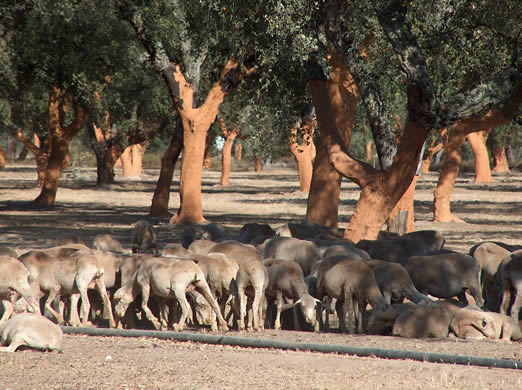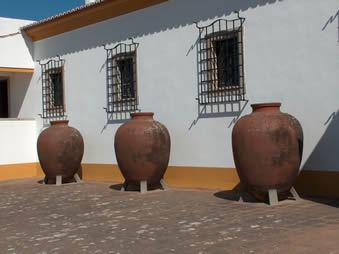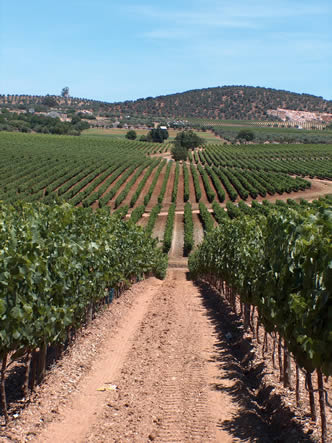|
Portugal's
Alentejo
Part
1: Introduction

An
Alentejo cork forest, plus sheep
As
a wine-producing country, one of Portugal’s great strengths is
its diversity. At one extreme lie the fresh, light, zippy Vinho
Verde wines from the damp, green, northern Minho, and at the
other there are the rich, concentrated red wines from the hot  Alentejo in the south, with a whole spectrum of flavours in
between. The Alentejo is where Portugal’s climate finally
escapes the Atlantic influence, and the scenery changes to
large, gently undulating plains that experience baking hot
summers and cold winters more typical of continental weather
systems. Think of it as Portugal’s ‘new world’, with the
potential to make extrovert, ripe wines with a taste of the sun
about them. This is the least populated of Portugal’s regions,
and instead of the smallholdings that typify the agricultural
landscape elsewhere, the Alentejo has many large estates.
Referred to as the ‘bread basket’ of Portugal, wheat is the
most important crop here, with the poorer soils being reserved
for olive trees, cork oaks and vineyards. If you want to
locate the Alentejo on a map of Portugal, it's inland and down a
bit from Lisbon, touching the Spanish border on the east and the
Algarve is at its south end.
Alentejo in the south, with a whole spectrum of flavours in
between. The Alentejo is where Portugal’s climate finally
escapes the Atlantic influence, and the scenery changes to
large, gently undulating plains that experience baking hot
summers and cold winters more typical of continental weather
systems. Think of it as Portugal’s ‘new world’, with the
potential to make extrovert, ripe wines with a taste of the sun
about them. This is the least populated of Portugal’s regions,
and instead of the smallholdings that typify the agricultural
landscape elsewhere, the Alentejo has many large estates.
Referred to as the ‘bread basket’ of Portugal, wheat is the
most important crop here, with the poorer soils being reserved
for olive trees, cork oaks and vineyards. If you want to
locate the Alentejo on a map of Portugal, it's inland and down a
bit from Lisbon, touching the Spanish border on the east and the
Algarve is at its south end.
 Aside
from the many tourist attractions in the region (such as the
towns of Evora (left), Borba and Estremoz), it is wine
that is currently putting the Alentejo region on the map, and
more specifically, its red wines. There are two distinct styles
of Alentejo red. First, there is what can loosely be termed the
traditional style. These often combine earthy, herby,
undergrowth-like savoury flavours and aromas with the fruit.
Traditional Alentejo wines are often complex and reasonably age
worthy. Then there is the modern style, perhaps best
demonstrated by the wines of Esporão,
João Portugal Ramos or Sogrape’s new Alentejo Reserva. These
wines show lots of intense fruit, with a richness that is quite
‘new world’ in character, and not a million miles away from
the style that has made Australian
wines such a success over Aside
from the many tourist attractions in the region (such as the
towns of Evora (left), Borba and Estremoz), it is wine
that is currently putting the Alentejo region on the map, and
more specifically, its red wines. There are two distinct styles
of Alentejo red. First, there is what can loosely be termed the
traditional style. These often combine earthy, herby,
undergrowth-like savoury flavours and aromas with the fruit.
Traditional Alentejo wines are often complex and reasonably age
worthy. Then there is the modern style, perhaps best
demonstrated by the wines of Esporão,
João Portugal Ramos or Sogrape’s new Alentejo Reserva. These
wines show lots of intense fruit, with a richness that is quite
‘new world’ in character, and not a million miles away from
the style that has made Australian
wines such a success over  recent years. Both Alentejo styles are interesting and
worthwhile, but it is the latter, more modern group of wines
that has been largely responsible for putting the Alentejo on
the map as one of Portugal’s most important red wine
regions.
recent years. Both Alentejo styles are interesting and
worthwhile, but it is the latter, more modern group of wines
that has been largely responsible for putting the Alentejo on
the map as one of Portugal’s most important red wine
regions.
Traditional
Portuguese grape varieties dominate the region, but newcomers
such as Syrah and Cabernet Sauvignon are beginning to make
inroads, often blended with the local varieties. Some white
wines are made in the Alentejo, but it’s the reds that are
forging the region’s reputation. Demand for Alentejo wines,
with their ripe fruit and full-bodied character, has been such
that vineyard land here is among the most expensive in the whole
country. Because many of the estates are fairly large and the
climate is so reliable, economies of scale mean that Alentejo
wines can combine quality with affordability, which is more of a
challenge in Portugal’s more northerly regions.
I
visited several of the leading estates in June 2005 to try to
get a fuller picture of the new wines emerging from this
interesting region, and this series takes an in depth look at
what I found.
Back
to top
|